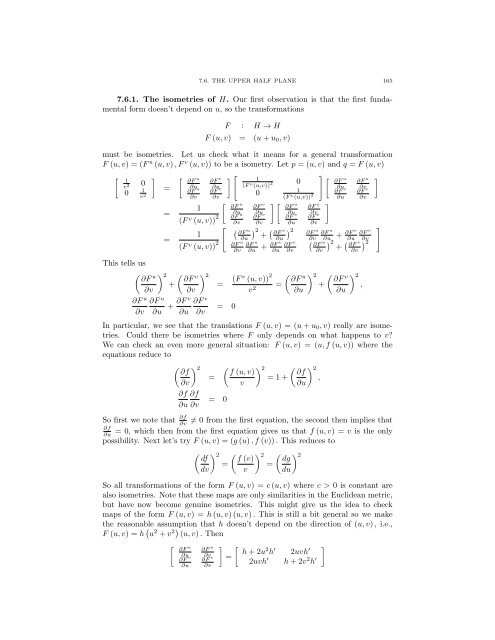Lecture Notes for 120 - UCLA Department of Mathematics
Lecture Notes for 120 - UCLA Department of Mathematics
Lecture Notes for 120 - UCLA Department of Mathematics
Create successful ePaper yourself
Turn your PDF publications into a flip-book with our unique Google optimized e-Paper software.
7.6. THE UPPER HALF PLANE 165<br />
7.6.1. The isometries <strong>of</strong> H. Our first observation is that the first fundamental<br />
<strong>for</strong>m doesn’t depend on u, so the trans<strong>for</strong>mations<br />
F : H ! H<br />
F (u, v) = (u + u 0 ,v)<br />
must be isometries. Let us check what it means <strong>for</strong> a general trans<strong>for</strong>mation<br />
F (u, v) =(F u (u, v) ,F v (u, v)) to be a isometry. Let p =(u, v) and q = F (u, v)<br />
apple 1<br />
apple "<br />
#<br />
v<br />
0<br />
@F<br />
u<br />
@F v<br />
1<br />
apple<br />
0<br />
@F<br />
u<br />
@F u<br />
2<br />
1 = @u @u (F v (u,v)) 2 @u @v<br />
1<br />
0<br />
v<br />
0 2 (F v (u,v)) 2<br />
=<br />
=<br />
@F u<br />
@v<br />
@F v<br />
@v<br />
apple<br />
1<br />
@F<br />
u<br />
(F v (u, v)) 2 @u<br />
"<br />
1<br />
(F v (u, v)) 2<br />
@F v<br />
@u<br />
@F v<br />
@v<br />
@F v<br />
@u<br />
@F v<br />
apple @F<br />
u<br />
@u<br />
@F v<br />
@F u<br />
@v<br />
@F v<br />
@v @u @v<br />
@F u 2<br />
@u +<br />
@F v 2 @F u @F u<br />
@u @v @u<br />
+ @F v @F v<br />
@u @v<br />
@F u<br />
@u<br />
+ @F v @F v @F u 2<br />
@u @v @v +<br />
@F v 2<br />
@v<br />
@F u<br />
@v<br />
@F u<br />
@v<br />
This tells us<br />
✓ ◆ @F<br />
u 2 ✓ ◆ @F<br />
v 2<br />
+ = (F v (u, v)) 2 ✓ ◆ @F<br />
u 2 ✓ ◆ @F<br />
v 2<br />
@v @v<br />
v 2 = + ,<br />
@u @u<br />
@F u @F u<br />
@v @u + @Fv @F v<br />
= 0<br />
@u @v<br />
In particular, we see that the translations F (u, v) =(u + u 0 ,v) really are isometries.<br />
Could there be isometries where F only depends on what happens to v?<br />
We can check an even more general situation: F (u, v) =(u, f (u, v)) where the<br />
equations reduce to<br />
✓ ◆ 2 ✓ ◆ 2 ✓ ◆ 2 @f<br />
f (u, v)<br />
@f<br />
=<br />
=1+ ,<br />
@v<br />
v<br />
@u<br />
@f @f<br />
= 0<br />
@u @v<br />
So first we note that @f<br />
@v<br />
6=0from the first equation, the second then implies that<br />
@f<br />
@u<br />
=0, which then from the first equation gives us that f (u, v) =v is the only<br />
possibility. Next let’s try F (u, v) =(g (u) ,f(v)) . This reduces to<br />
✓ ◆ 2 df<br />
=<br />
dv<br />
✓ ◆ 2 f (v)<br />
=<br />
v<br />
✓ ◆ 2 dg<br />
du<br />
So all trans<strong>for</strong>mations <strong>of</strong> the <strong>for</strong>m F (u, v) =c (u, v) where c>0 is constant are<br />
also isometries. Note that these maps are only similarities in the Euclidean metric,<br />
but have now become genuine isometries. This might give us the idea to check<br />
maps <strong>of</strong> the <strong>for</strong>m F (u, v) =h (u, v)(u, v) . This is still a bit general so we make<br />
the reasonable assumption that h doesn’t depend on the direction <strong>of</strong> (u, v) , i.e.,<br />
F (u, v) =h u 2 + v 2 (u, v) . Then<br />
#<br />
apple @F<br />
u<br />
@u<br />
@F v<br />
@u<br />
@F u<br />
@v<br />
@F v<br />
@v<br />
apple h +2u<br />
=<br />
2 h 0 2uvh 0<br />
2uvh 0 h +2v 2 h 0
















